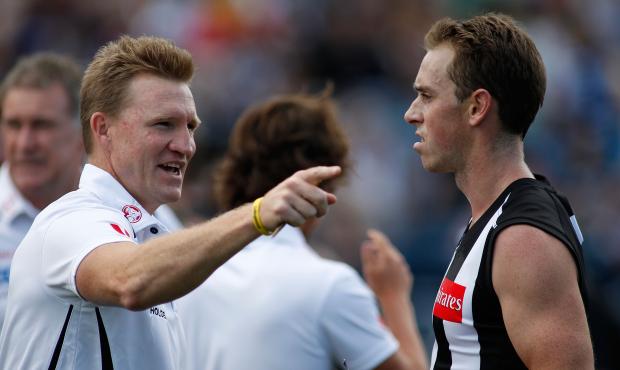THERE are plenty of words you could use to describe the frenetic activity that takes place in an AFL coaches box every weekend.
It really is organised chaos.
There's plenty going on. Rotations, tactics, injuries and ensuring effective communication between the box and the interchange bench are just some of what takes place during a match.
From my perspective, it is all about receiving and interpreting critical information and, like the team on the ground, ensuring that everyone has their specific role and sticks to it.
We all have to know the role we play and its importance, and then being able to focus on that. It takes practice because you can get caught up in the emotion of what's going on in a game, so you keep coming back to the same question: What's your role and how can you influence the result as effectively as possible?
The major difficulty we find is that the message can change as you go down the chain of command.
The coach passes on a message to the bench, which tells the runner, who then tells the player. Your key message can be diluted each time gets it passed along, to the point where its execution barely resembles your original instruction.
To that end, a small, but essential requirement each week is to ensure the communication devices between the box and the bench are in full working order and that our communication in the box is clear and accurate.
My line coaches at Collingwood - Ben Hart (backline), Matthew Lappin (forwards) and Robert Harvey (midfield) - are vocal in the box during games and are very specific about what they're seeing in their respective areas. Their feedback is complemented by Rodney Eade's observations of the game patterns and the opposition.
We also monitor KPI’s through Champion Data. The large majority of information is distilled around our focuses going into the game and how effective, or otherwise they are throughout the match.

Nathan Buckley delivers the message directly to skipper Nick Maxwell. Picture: AFL Media
One on the stats, one on rotations and one on the match-up board makes seven all up that contribute to the mix needed to make the right decisions at the right time.
All communication from the box goes to one person on the bench, which traditionally has been our head of football, Geoff Walsh, although we are looking at some alternatives this year. Whichever runner is not on the ground is also encouraged to have an ear to the communication with the coaches.
I'm a telephone man rather than a headset wearer but I do think open communication is important and its vital that everyone can hear information that's coming back from the bench. We put a speaker in the coach's box to convey any information from the bench so that it doesn't have to be repeated.
Rotations are the call of David Buttifant, our head of fitness, although the players take a fair degree of ownership in that, and much of the coaching that you do during the week empowers the players to make those calls during a match.
Major positional changes are made from the team in the box. A lot of them are best-fit scenarios that you want to coach the leaders of your football club around.
No matter how attuned you are to the game, there's a lag period between what you see in the box and the message coming out from the runner so its important for the on-field leaders to pick that up. Again, you prepare for this during the week.
We have key statistics that we judge our game on and we get them continually fed back to us. One you can't get away from is contested ball. It’s a consistent in an everchanging game.
In so far as analyzing what happens in a game, the most important thing is to find trends quickly and act upon them.
You want to get key data minutes before you need to make a decision, not minutes afterwards. If you don't have the information or if a crucial piece of data is overlooked, then that impacts upon decision-making. Sometimes these are stats, at other times they are observations. Neither one nor the other can be relied upon categorically to paint the picture you need.
Sometimes you'll act on a hunch, sometimes it'll slap you in the face. In reality, stats are just supporting what you're seeing in a game.
I'm often asked what it is like in the coach's box in those few minutes before the start of the game. The coaching team is only up there for a couple of minutes but it seems like a long time. All your work is done and you are just waiting to get started.
You end up going through a checklist. Have we done this? Have we done that? All good? If so, then we're all set and ready to go.
It's just like the players before they run out on the field. They have ticked off everything they have done during the week so now there are no excuses. It's time to go.
Quite often that vacuum before the players run to position is filled by a wise crack or a gag of some sort. It's important to enjoy what we do. We are all competitive animals and love to win. Staying loose and sharp is a big part of the process.
After a full week of planning and coaching, those last moments are the calm before the storm. Anything can happen in 120 minutes of footy and inevitably … it does!


